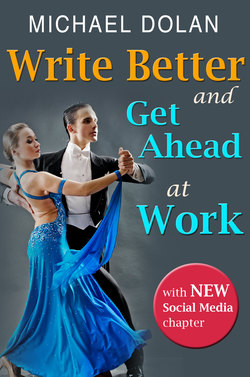Читать книгу Write Better and Get Ahead At Work - Michael Dolan - Страница 8
На сайте Литреса книга снята с продажи.
Making a Universal Format Your Own
ОглавлениеTo make this book work for you, begin by writing down “What I like.” This book—a mere collection of ink on paper—is nothing until you make it come alive for you. The funny contradiction of Write Better and Get Ahead at Work is that the book sets out a single format that each individual writer makes his or her own. Once you decide what you want, the guidebook shows you the format. Original only on the surface, LEB123S is a simple way of stating what you and most readers already know in your hearts. The format is a shorthand way of describing (and remembering) how people in Western Civilization think.
This arrangement of ideas surrounds us in language everyday, in newspapers, at work and in books. You have heard a similar idea before: “Your writing should have a beginning, middle and end.” When I first began teaching writing to people at a community college, I noticed that this strategy did not help them at all. Who could disagree with “beginning, middle, and end”? But what does it mean? What should come first? How do you know which information goes in the middle? How do you know when you have reached the end?
To make the terms of language organization more useful to people who want to improve their work right away, I devised the format to explain exactly what goes into each of the three sections. The format—with variations—applies to any memo, letter or report because it is the fundamental structure of any message, the progression of ideas your reader is expecting to hear. The beginning is a strong lead statement, getting to the point right away with perhaps a bit of explanation to follow. The middle is historical background information and three or so relevant facts to support the lead. The end is a summary, which for writing at work usually means the action resulting from your message.
Where did this format come from? LEB123S comes from the most successful and efficient writing business in the world today: daily newspapers. Compare the writing at most businesses to the writing of a newspaper. In less than 24 hours, a newspaper will produce a story written by one person, edited by two more, reviewed by three or four others and finally printed. The end product is readable, accurate (nearly always), and relevant to the reader now. What happens where you work? Possibly something like this: the boss gives someone a writing assignment; after a day of thinking about it and another day of producing two or three drafts, the writer produces a memo that the boss may or may not like. The final product—even when it is useful for the intended reader—too often feels “wordy” or “boring.”
Building on your fundamental work, see the new Chapter on social media. You’ll find some helpful idea about writing more effectively online.
